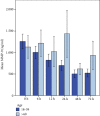Polytrauma in Older Adults Leads to Significantly Increased TIMP-1 Levels in the Early Posttraumatic Period
- PMID: 32258173
- PMCID: PMC7085877
- DOI: 10.1155/2020/4936374
Polytrauma in Older Adults Leads to Significantly Increased TIMP-1 Levels in the Early Posttraumatic Period
Abstract
Background: Patients after polytrauma regularly suffer from posttraumatic immune system destabilization, which closely influences the further clinical development. Increasing age has recently been identified as an isolated risk factor for an adverse outcome after major trauma. Higher rates and intensity of acute inflammation following severe injury suggest that deregulated inflammation may contribute to these higher rates of posttraumatic morbidity and mortality in older adults. MMP-9 and TIMP-1 have been found to play a major role in posttraumatic immune disorder in a previous genome-wide mRNA analysis.
Objective: The aim of this study was to evaluate the differences in serum protein dynamics in older and younger polytraumatized adults.
Methods: Blood samples were drawn immediately within 90 minutes after trauma and subsequently after 6, 12, 24, 48, and 72 h. Serum levels of TIMP-1 and MMP-9 were quantified using ELISA. Age groups were divided according to a cutoff of 60 years.
Results: 60 polytrauma patients (ISS > 16) were included (<60 years, n = 49; ≥60 years, n = 49; ≥60 years, n = 11). Serum TIMP-1 and MMP-9 levels showed a highly significant serum dynamic in young and old polytrauma patients (p < 0.001). Patients ≥ 60 years showed significantly higher overall TIMP-1 levels (p < 0.001). Patients ≥ 60 years showed significantly higher overall TIMP-1 levels (p = 0.008). TIMP-1 levels showed a significant maximum after 72 h in the older study population. MMP-9 levels were nonsignificantly higher during the whole observational period in older polytrauma patients when compared to younger patients.
Conclusion: The posttraumatic immune response is characterized by significantly higher TIMP-1 levels in older polytrauma patients. This significant association between TIMP-1 levels and patients' age indicates a more extensive immune dysregulation following major trauma in older adults.
Copyright © 2020 Mareen Braunstein et al.
Conflict of interest statement
The authors declare that no conflicts exist.
Figures







Similar articles
-
Concentration kinetics of serum MMP-9 and TIMP-1 after blunt multiple injuries in the early posttraumatic period.Mediators Inflamm. 2012;2012:435463. doi: 10.1155/2012/435463. Epub 2012 Mar 27. Mediators Inflamm. 2012. PMID: 22547904 Free PMC article.
-
TIMP-1, MMP-2, MMP-9, and PIIINP as serum markers for skin fibrosis in patients following severe burn trauma.Plast Reconstr Surg. 2003 Apr 1;111(4):1423-31. doi: 10.1097/01.PRS.0000049450.95669.07. Plast Reconstr Surg. 2003. PMID: 12618601
-
Neutrophil Gene Expression Patterns in Multiple Trauma Patients Indicate Distinct Clinical Outcomes.J Surg Res. 2022 Sep;277:100-109. doi: 10.1016/j.jss.2022.03.011. Epub 2022 Apr 25. J Surg Res. 2022. PMID: 35472724
-
Matrix metalloproteinase-9, -10, and tissue inhibitor of matrix metalloproteinases-1 blood levels as biomarkers of severity and mortality in sepsis.Crit Care. 2009;13(5):R158. doi: 10.1186/cc8115. Epub 2009 Oct 2. Crit Care. 2009. PMID: 19799791 Free PMC article.
-
Diagnostic Value of Matrix Metalloproteinase-9 and Tissue Inhibitor of Matrix Metalloproteinase-1 in Sepsis-Associated Acute Kidney Injury.Tohoku J Exp Med. 2015 Oct;237(2):103-9. doi: 10.1620/tjem.237.103. Tohoku J Exp Med. 2015. PMID: 26399271
Cited by
-
Early systemic immune biomarkers predict bone regeneration after trauma.Proc Natl Acad Sci U S A. 2021 Feb 23;118(8):e2017889118. doi: 10.1073/pnas.2017889118. Proc Natl Acad Sci U S A. 2021. PMID: 33597299 Free PMC article.
-
Serum levels of matrix metalloproteinases 1, 2, and 7, and their tissue inhibitors 1, 2, 3, and 4 in polytraumatized patients: Time trajectories, correlations, and their ability to predict mortality.PLoS One. 2024 Mar 8;19(3):e0300258. doi: 10.1371/journal.pone.0300258. eCollection 2024. PLoS One. 2024. PMID: 38457458 Free PMC article.
References
MeSH terms
Substances
LinkOut - more resources
Full Text Sources
Research Materials
Miscellaneous

